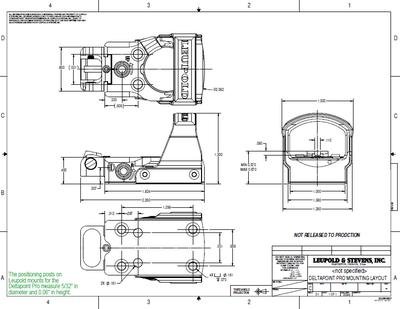
infoRMATION
Born from a career in law enforcement and refined through years of competitive pistol shooting, these optic plates were developed with one goal in mind — to set a new standard in quality and performance. Extensive testing and evaluation of RDS systems for a major law enforcement agency revealed critical weaknesses in many existing designs. Unlike mass-produced alternatives made from low-cost materials, these plates are engineered for strength, precision, and reliability.
Each plate is crafted from premium materials, meticulously designed for structural integrity, and built to perform flawlessly under demanding conditions — all while maintaining a clean, refined appearance.
Proudly made in the USA, every effort is taken to source materials from American suppliers. While this commitment adds to production costs, it ensures uncompromising quality and craftsmanship you can trust in every product.
Shipping:
The business operates as a one-person shop with a single machine, producing plates exclusively on an as-ordered basis rather than maintaining large material inventories. Most plates with anodized or raw titanium finishes typically ship within 14 working days. Plates requiring a DLC finish are sent to a specialized coating partner whose current turnaround time has extended beyond initial estimates and is now generally between 3 and 6 weeks.
As a growing business, occasional delays may occur, particularly when fulfilling larger orders. However, every effort is made to meet customer expectations and ensure satisfaction. The business sincerely appreciates customers’ patience and understanding.
Titanium:
When it comes to performance under pressure, heat is the silent factor that separates ordinary materials from exceptional ones. Metals react to heat in two ways — thermal expansion and thermal stress. Expansion causes the metal to grow, while thermal stress is the force that buildup exerts — often transferred directly to the mounting screws that hold your optic in place.
Most plates on the market are made from aluminum or steel. Aluminum expands significantly under heat, while steel, though denser, creates greater internal stress. Both materials experience heat effects up to three times greater than titanium.
In a cycling slide, every component — the slide, screws, plate, and optic — is subjected to heat and movement, constantly pressing against each other. That’s why titanium stands out. Its exceptional thermal stability minimizes expansion and stress, helping maintain a secure, consistent connection even under extreme conditions. The result is greater reliability, improved longevity, and unwavering performance when it matters most.
Slide Weight:
It is widely known that steel is heavier than titanium or aluminum. While the plates in question are relatively small and the weight difference may seem minor, even a small increase can affect the performance of a factory pistol. Firearms are engineered to operate with a specific recoil spring weight and within a narrow range of factory ammunition power. Adding even an ounce or two to the slide—through a plate or optic—alters the dynamics of its cycling. Increased slide weight can slow extraction, ejection, and feeding, potentially impacting chambering and overall reliability. As a result, you may need to replace the recoil spring more frequently, perform more regular cleaning, and replace parts sooner. These factors should be carefully considered, as adding weight to the slide can lead to reliability issues over time.
Duty Holsters:
The Carbon Port model plate for the M&P is fully compatible with the Safariland 6360, except in configurations using the SRO or RMR-HD. Compatibility with additional holster models is currently under evaluation.
